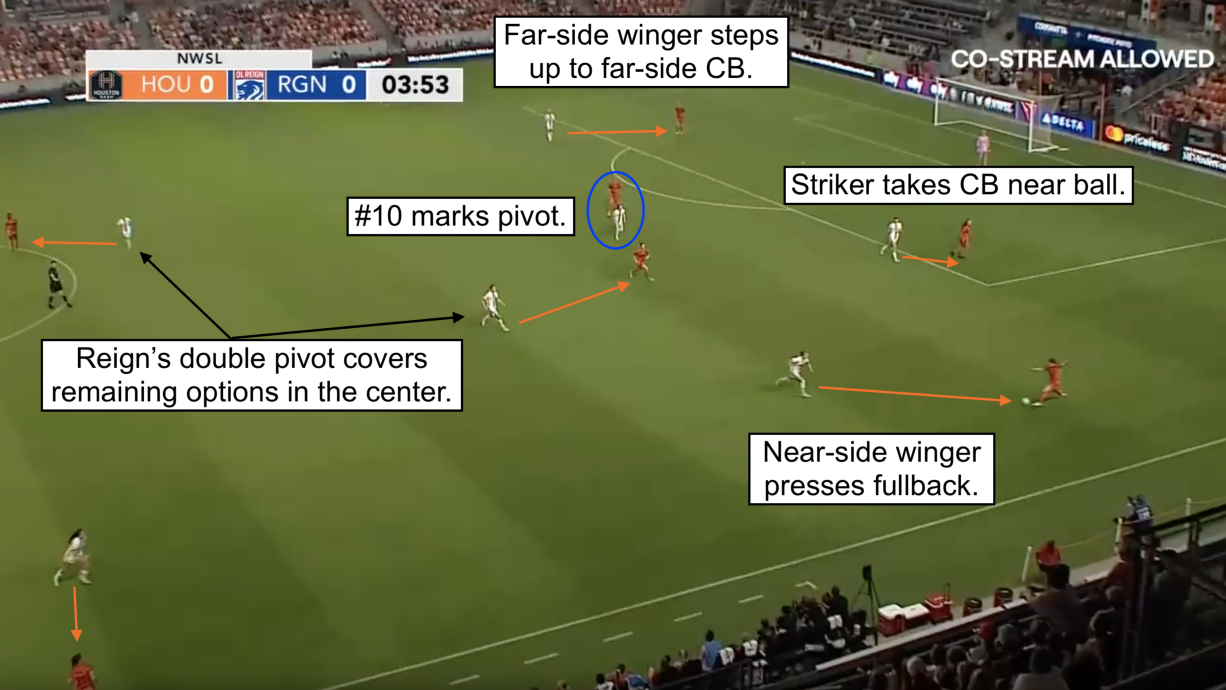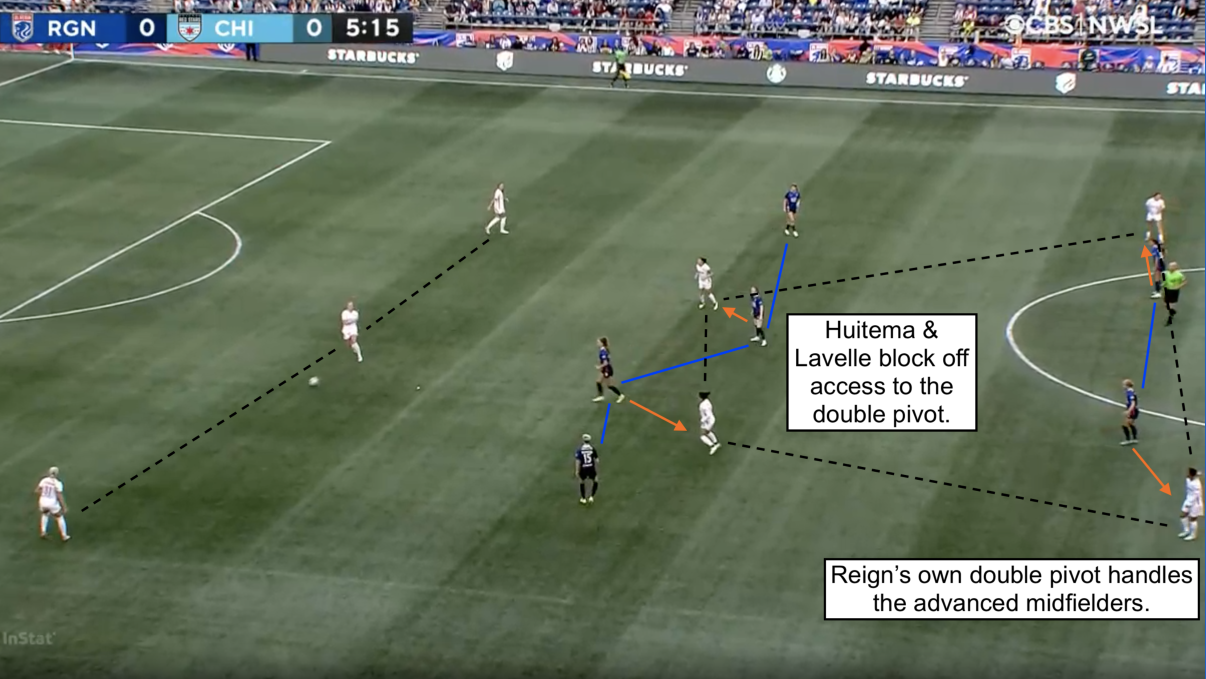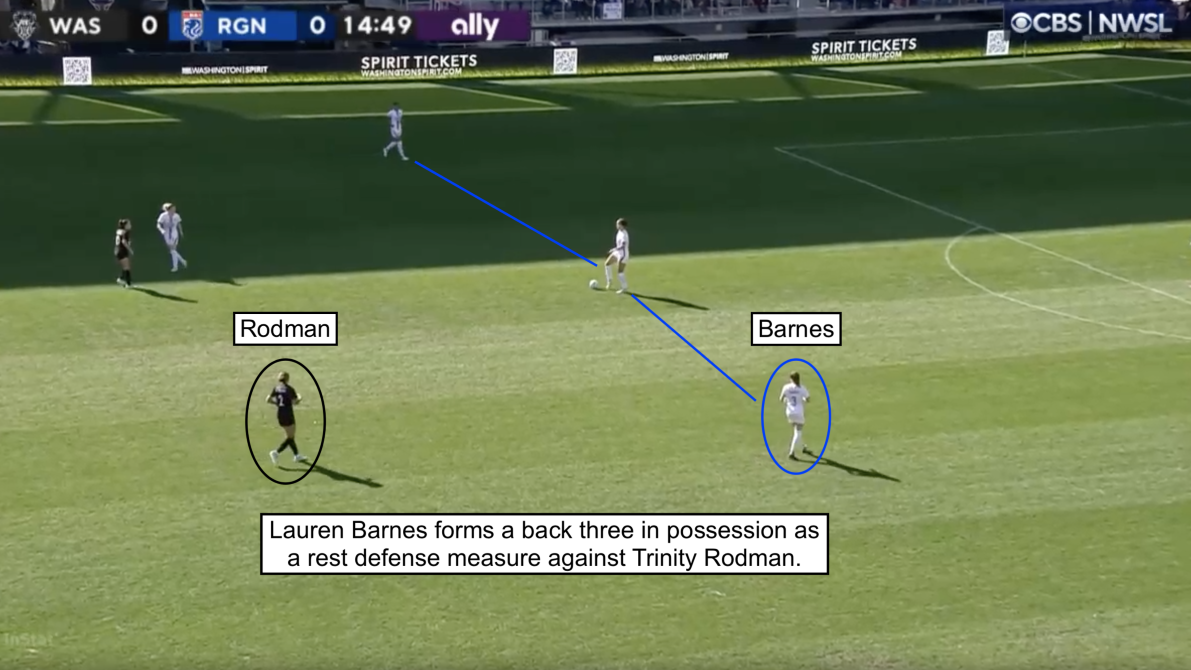OL Reign coach Laura Harvey painted a picture of frustration following her side's 1-0 defeat to the Washington Spirit in their 2023 NWSL season opener.
"Everyone who knows me knows my pet peeve is when you don't do defending throw-ins right," she said, referring to the 54th minute sequence in which Spirit winger Trinity Rodman was allowed to burst away freely into space and score.
While the Reign may not have met Harvey's exacting standards on Rodman's goal, Reign players largely did their job out of possession the rest of the night, conceding just 0.77 expected goals. Expected goals, or xG, measure the quality of chances created -- the higher the expected goals, the more dangerous a team was. The xG on Rodman's goal was only 0.03, even if the breakdown leading to the shot was a mistake.
The following week, in Saturday's 2-0 win against Gotham FC, the Reign looked more like the squad Harvey wanted, maintaining a clean sheet and holding the explosive attack of Lynn Williams and Midge Purce to a paltry 0.52 xG.
Even though the Reign lost their season opener, such impressive underlying numbers reflect a defense that already appears to be reliable in shutting down opposing attacks, even at this early stage in the season -- and it suggests OL Reign will continue to be difficult to break down. This is unsurprising, though, because the Reign are building on a tactical approach that saw them concede the least amount of goals and xG in the league last season.
So how do they do it, and how can they keep it going?
How the Reign's defensive system works under Harvey
The key to OL Reign's success lies in Harvey's tactical organization and philosophy. While the Reign are certainly not the most aggressive pressing team ever, they do defend quite proactively, trying to coax sides into preferred areas before springing out of a mid-high stance. The Reign do this by employing a flexible 4-2-3-1 structure, with the wingers given decisive roles in the system.
Since the Reign's No. 10 in the midfield -- primarily Rose Lavelle -- is generally glued to the opposition pivot, it is the responsibility of the far-side winger to maintain access to one center-back while the striker takes the other. This creates a lopsided look that denies all central outlets for the opponent.
You will sometimes see the Reign's asymmetric shape manifest before teams have even begun to initiate play, discouraging opponents from closing down the more aggressively-positioned wide player. But the Reign often wait until their rivals choose a side before pushing the likes of winger Megan Rapinoe forward.
 Here is OL Reign's defensive structure once they guide the ball to the touchline.
Here is OL Reign's defensive structure once they guide the ball to the touchline.
In doing so, the Reign are able to push their opponents to one side of the field, essentially locking them in. Think of the far-side winger's movement towards the center-back as a spike strip being laid down on the last remaining escape route. This is where the Reign amp up the intensity, closing down hard on the relevant flank to compress space and force turnovers.
When having to defend deeper, the Reign maintain their general principles -- blocking off the center and locking play to one side -- but dial down the aggression from the front and shift the height of their wingers. Instead of focusing on the center-back, the far-side winger will pinch into midfield, occasionally coming so narrow that they cross into the other vertical half of the pitch. This follows Harvey's desire to ensure that her team is compact near the ball.
The fluid role of OL Reign's wingers
Those are the general ideas, but there is also a degree of variability in how the Reign approach things -- after all, soccer does not always occur in a predetermined and predictable fashion. The sport is transient by nature, presenting players with evolving scenarios that need to be dealt with on the fly in order to fulfill the tactical plan laid out for them.
Harvey deals with this ever-changing reality by giving her wingers a high degree of autonomy in their decision-making, trusting that they can execute complex decisions in ways that always adhere to the spirit of her tactical logic. It helps, of course, that she has personnel capable of handling this, with players like Rapinoe and Bethany Balcer showing keen judgement when going off-script.
For example, it is not uncommon to see the wide attacker on the far side abandon the idea of stepping out to a center-back if play is being switched to the other side. While the Reign would ideally like to prevent a switch, sometimes there's too much space to close down and it would be risky to try. Consequently, it makes more sense to hold position and wait for the rest of the team to reset, allowing the other winger to then step forward and recreate Harvey's preferred shape.
The Reign's wingers are also empowered to be quite opportunistic in their pressing. On occasion, they might see a chance to veer from their duties in the mid-high block to pounce on the blind-side of a free central midfielder, ensuring that the middle remains congested and things are kept to one half of the pitch. Other times, the near-side winger might charge at the center-back (remember, it's normally the winger away from the play that does this) instead of hanging back. That could be because the striker is not in the right position to press, or because there was simply the prospect of an unexpected turnover due to a bad touch.
As a result of the adaptable, narrow positioning of Harvey's wingers, everyone else's jobs become easier. The striker and central midfielders can follow their marks more aggressively -- increasing the chances of generating a turnover -- safe in the knowledge that a Rapinoe or Tziarra King will fill in the gaps to prevent the opposition from escaping to the far side.
How the Reign adapt to their opponent
Harvey is quite adaptable herself, tweaking her scheme based on the different challenges she encounters. Case in point: against the Chicago Red Stars last season, OL Reign faced a back three supported by a box midfield -- four central midfielders positioned quite literally in a square shape. That provided the Red Stars with a lot of players through the middle, and potentially an ability to deal with the Reign's tendency to congest the midfield.
Against Chicago, there was the option of pressing with both wingers at the same time -- Rapinoe and Balcer -- to generate a three-versus-three up top. However, Harvey was concerned about the numbers advantage Chicago would have in the center -- their four midfielders versus the trio of Lavelle, Nikki Stanton, and Olivia Van der Jagt if Reign striker Jordyn Huitema joined Rapinoe and Balcer in pushing higher up the pitch.
Thus, Harvey ordered Huitema to sit off in line with Lavelle, creating a 4-2-4 formation of sorts that left Chicago's centermost center-back largely unbothered in favor of covering the two deeper central-midfield options. This allowed the Reign's double pivot to mark the advanced threats in the middle, thereby neutralizing the Red Stars' tactical advantage. With Rapinoe and Balcer free to press the wide center-backs, the Reign also retained a degree of initiative and control over what zones Chicago passed into.
 OL Reign's 4-2-4 setup vs. the Chicago Red Stars last season.
OL Reign's 4-2-4 setup vs. the Chicago Red Stars last season.
Harvey's tinkering worked like a charm -- OL Reign absolutely dominated the first half, out-shooting Chicago 13-5 and creating 2.88 xG to the Red Stars' 0.55. Nevertheless, as has often been the story for the Reign, inefficiency in front of goal let them down and they didn't capitalize on their best period, allowing the Red Stars to come back stronger in the second half and steal a 2-2 draw.
But these adjustments also add further insight into Harvey's true priorities on defense: no matter what, she refuses to let the Reign concede the numbers advantage in the center, even if it means giving up access to the back line. If the middle is protected, the opposition will inevitably find themselves moving to the flank, where Harvey's side can use the touchline to limit their opponents' space and press with less risk.
Defense and offense as one
Throughout history, bright tactical minds have generally understood that offense and defense operate on a continuum. If too many players commit forward, it will be harder to defend a counter-attack. If too many players are back defending, it likewise becomes more difficult to launch offense in transition.
What's changed in recent years are the methods of tackling this fundamental truth of soccer. In the past, coaches simply accepted this tradeoff. Today, many aim to have their cake and eat it too, structuring their offenses in ways that maximize attacking output while simultaneously preparing for defensive transition (this is known as "rest defense"), and vice-versa.
For the Reign, Harvey handles the defensive side of the continuum with the aforementioned pressing scheme, which creates offense by winning possession high up the pitch. Last season, no team forced more high turnovers and produced more shots from those turnovers than OL Reign. The intensity of their press, as measured by "passes allowed per defensive action" or PPDA, put them second in the NWSL, ranking behind only the San Diego Wave.
Harvey's solutions for the offensive part of the continuum are more subtle. As a team that is quite direct and quick in their ball circulation, her rest defense doesn't involve a lot of intricate possession structures. Instead, she tries to ensure that there is always support around players receiving long passes, enabling the Reign to fight for second balls or quickly attempt to regain possession if they lose their initial duels.
Another aspect of Harvey's method is baked into her lineup selection. In order to balance against the hyper-offensive tendencies of right-back Sofia Huerta, Harvey utilizes the relatively conservative profile of left-back Lauren Barnes -- who prefers to pass from deeper locations rather than bomb forward -- to provide the Reign with extra defensive cover when they lose the ball.
This strategy was very prominent in their recent matches this season against the Spirit and Gotham. In order to deal with Rodman for the Spirit, and the duo of Midge Purce and Lynn Williams for Gotham, Barnes acted as a wide center-back in possession, forming a back three that situated her even deeper than normal. Harvey's alteration ensured that Barnes and the other wide defender were always positioned in front of the tricky winger(s) in case of a turnover (another example of how Harvey adapts based on the opponent).
 Laura Harvey's tactical adjustment vs. the Spirit in the season opener.
Laura Harvey's tactical adjustment vs. the Spirit in the season opener.
Of course, this full-back asymmetry has implications for attacking play, which Harvey solves by picking wingers that occupy contrasting spaces. The Reign coach loves to deploy Balcer or Lavelle -- individuals who enjoy drifting inside for different reasons -- on the right, opening a runway for Huerta to barrel down. On the left, Rapinoe starts when fit, acting more as a traditional wide attacker who holds width ahead of the less adventurous Barnes.
In this way, Harvey's tactical logic comes full circle, reflecting a coaching philosophy that is fully in tune with the tactical demands of modern soccer. That is why, despite questions over their finishing and prior playoff disappointments, the Reign are still better placed than most teams to make a serious run for the 2023 NWSL title. If defense wins championships, the Reign are in prime position.
